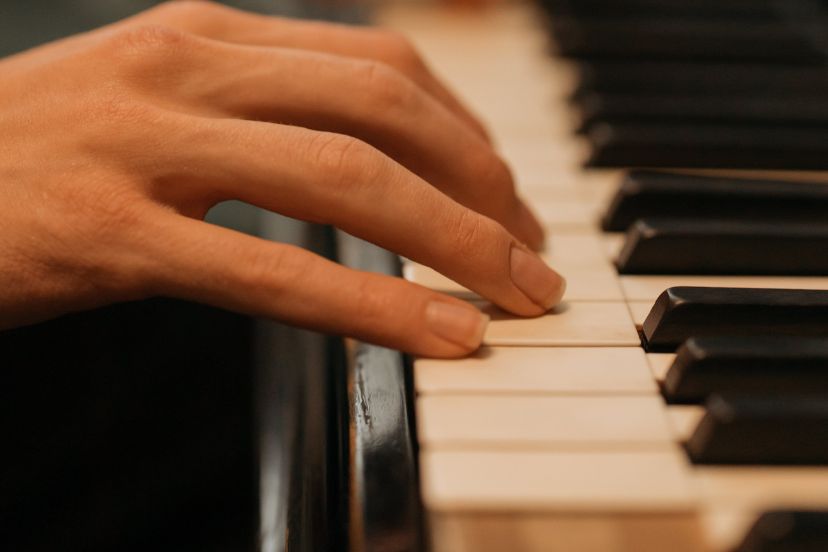For those looking to learn piano in a creative and enjoyable way, Creative Piano Academy offers…
Piano Acoustics: Understanding the Science Behind the Sound

The acoustic piano, a grand instrument renowned for its versatility and richness in sound, is a marvel of music engineering. Its beautiful melodies emerge from a complex interplay of physics and craftsmanship, collectively known as piano acoustics.
At the heart of the piano’s acoustics lie the strings. Each string on a piano is meticulously designed and positioned to produce a specific note when struck.
How many strings are there in a piano, you might ask? A standard grand piano model has more than 230 strings, each contributing to the symphony that we hear when the keys are played.
Role of Piano Strings in Piano Acoustics
Piano strings vary significantly in length, thickness, and tension to create a broad spectrum of pitches. Each note on a piano is typically associated with two or three strings of the same length and tension, which are tuned to the same frequency to produce the same note. This design allows for a louder volume and a richer tone, as the vibrations of each string reinforce each other.
The lowest bass notes are produced by the longest and thickest strings, which are often wound with an additional layer of wire to increase their mass without excessively increasing their length or tension. As we move up the keyboard, the strings become progressively shorter, thinner, and under higher tension, which allows them to vibrate at higher frequencies.
This transition from the bass to the treble notes is gradual, with the bass strings giving way to the tenor strings around the middle of the keyboard, and then to the treble strings.
The speaking length of the string, which is the portion that vibrates to produce sound when struck by the hammer, is a critical factor in determining the pitch of a given note on a given instrument. The speaking length of a string is determined by its two end points – the bridge and the point where the string is strung to the frame.
When a key on the piano’s keyboard is pressed, a hammer inside the piano strikes the corresponding strings, causing them to vibrate. The vibrations are transmitted through the bridge to the soundboard, which amplifies the sounds.
Frequencies of Piano Strings
The frequency at which a string vibrates, and consequently the pitch of the note it produces, is determined by the string’s length, mass, and tension. Shorter, lighter, and tighter strings produce higher-pitched sounds, while longer, heavier, and looser strings produce lower-pitched sounds. This principle is the same not only for pianos but for other stringed instruments like guitars as well.
However, the sound that we hear when we play a note on a piano is not just a simple tone at one frequency. Each string also produces a series of what are called overtones, or harmonics, which are vibrations at frequencies that are multiples of the fundamental frequency of the string.
These overtones add complexity and richness to the sound of each note. The exact mix of overtones that a string produces depends on factors such as the material and thickness of the string, the point at which it is struck by the hammer, and the design of the piano.
Piano Tuning
In addition to the design of the strings themselves, the tuning of the piano also plays a crucial role in its acoustics. Piano tuners adjust the tension of each string to achieve the desired frequencies. In the process of tuning, the tuner will often break the octave into smaller intervals, ensuring that each note is in tune with its neighbors in that interval.
Tuning a piano is not a one-time task. Over time, the tension in the strings changes due to factors such as temperature and humidity changes, and the strings stretching under their own tension. Regular tuning ensures that the piano maintains its optimal sound.
Other Factors That Contribute to a Piano’s Sound
The sound that a piano produces is not solely determined by its strings and tuning. Other parts of the instrument, such as the soundboard, the hammers, and the case, also contribute to the piano’s acoustics. The soundboard, in particular, plays a crucial role by amplifying the vibrations of the strings and projecting the sound out of the piano.
Finally, the player’s technique also significantly affects the sound that the piano produces. The force with which the keys are struck, the speed at which they are released, and even the exact point at which the fingers make contact with the keys can all change the sound that the piano produces.

FAQs About Piano Acoustics
What are the strings on a piano made of?
Piano strings are made of high-tensile steel wire wound with copper wire in the bass section. The piano’s higher notes are typically plain steel wire.
How many strings does a typical piano have?
Pianos typically have 88 keys, and for each note, there is at least one string, two or three strings for most notes, and four for some of the bass notes.
What is the difference between piano string size gauges?
The strings in the bass register are thicker, and as we move towards the treble register, the strings become thinner in size.
Why do pianos have more than one string per note?
Pianos have more than one string for certain notes to increase the sound volume and richness. In addition to this, the additional strings also produce harmonics, making the tone more complex and resonant.
What is the pitch of a piano string?
The pitch of a piano string depends on the length and tension. The shorter and tighter the string, the higher the pitch will be.
How are piano strings tuned?
Each string is tuned by adjusting the tension of the string using tuning pins and a tuning wrench. By turning the pin, we stretch or loosen the string, changing its pitch.
What is a wound string on a piano?
A wound string is a string on a piano that is wrapped with metal wire, typically found only in the bass section.
How are piano strings inserted into the piano?
The strings are attached to hitch pins with loops at one end that you then insert through holes in the tailpiece. The other end of the string is strung onto the tuning pin.
Can a guitar string be used on a piano?
No. Guitars strings are not designed to withstand the tensile stresses of a piano, and they have completely different thicknesses, making them unsuitable for use on a piano.
How can I identify if a note on a piano has multiple strings?
If a note on a piano has more than one string, you can often see it by looking into the piano through the lid opening. There may be two or three wires which rest on the hitchpin.
Summary of Piano Acoustics
In conclusion, piano acoustics is a fascinating field that combines elements of physics, engineering, craftsmanship, and artistry.
The next time you sit down at a piano, take a moment to appreciate the intricate design and craftsmanship that goes into creating the beautiful sounds that fill the room.
Whether you’re a seasoned pianist or just starting your musical journey, understanding the science behind the sound can deepen your appreciation for this remarkable instrument.



